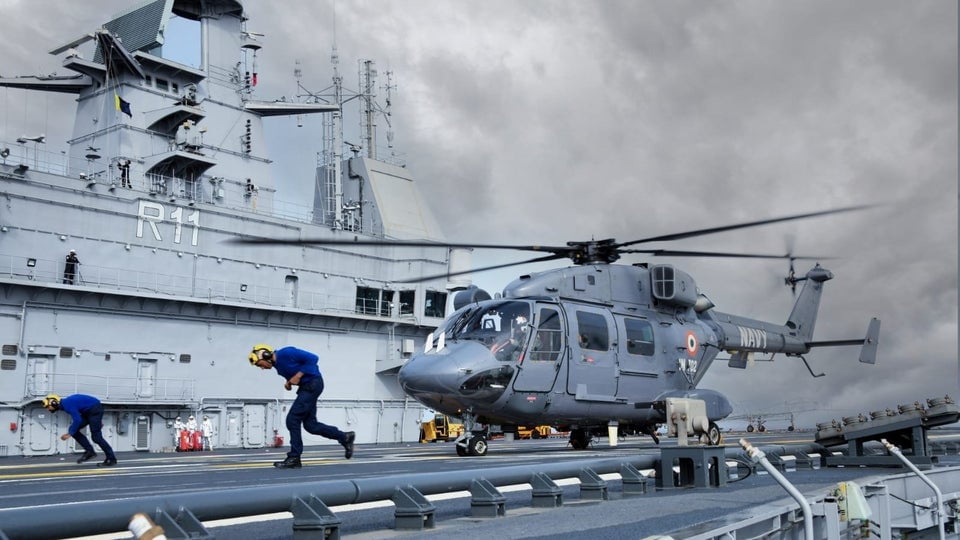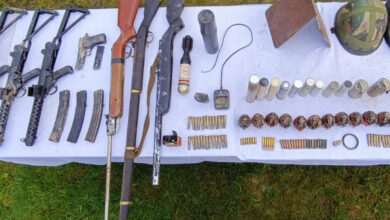Vikrant vs Fujian – How Does The Chinese PLA Navy’s Type 003 Carrier Compete Against The Second Aircraft Carrier Of The Indian Navy?

- The warship will also fly multi-role MH-60R helicopters, Kamov-31 helicopters, and other indigenously produced modern light helicopters.
- The Electromagnetic Aircraft Launch System (EMALS) allows the aircraft carrier to launch a wider variety of aircraft, in contrast to Fujian's far more sophisticated system.
The ship is anticipated to be delivered by the end of July, after which it might be commissioned on August 15—the same day as the 75th anniversary of Indian Independence.
The Navy tweeted that “Indigenous aircraft carrier Vikrant completed 4th phase of sea trials integrated trials of major equipment and systems, including key aviation equipment undertaken with further enhancement in performance, towards the delivery of the largest indigenous warship in Azadi Ka Amrit Mahotsav.”
The Navy has made photographs of the new aircraft carrier available, one of which features INS Vikrant from a distance and the other a Naval Dhruv helicopter flying above the flight deck. On the flight deck are also a Kamov Ka-31 helicopter and a MiG-29K fighter plane.
Indigenous Aircraft Carrier #Vikrant successfully completed 4th phase of Sea Trials
Integrated trials of major eqpt & systems, incl key aviation eqpt undertaken with further enhancement in performance, towards delivery of the largest indigenous warship in #AzadiKaAmritMahotsav pic.twitter.com/Kv3OlUJuV9— SpokespersonNavy (@indiannavy) July 10, 2022
Vikrant, an aircraft carrier built at the state-owned Cochin Shipyard Limited (CSL) with 76% indigenous materials, was created by the Directorate of Naval Design (DND) of the Indian Navy, joining the select group of nations that also includes the United States, the United Kingdom, Russia, France, and China.
According to a news statement from the Indian Navy and Cochin Shipyard Ltd., the indigenous design and construction of an aircraft carrier is “a shining example in the Nation’s drive for “AatmaNirbhar Bharat” and “Make in India Initiative” with more than 76 percent indigenous content.”
The first phase of sea trials on INS Vikrant ended in August 2021, while the second and third phases followed in October 2021 and January 2022, respectively.
The propulsion system, electrical and electronic systems, deck machinery, lifesaving equipment, and the ship’s navigation and communication systems all underwent endurance tests during these three phases of the trials.
India’s Vikrant vs China’s Fujian
In light of escalating tensions with China and the People’s Liberation Army (PLA) Navy of China expanding its excursions in the Indian Ocean Region, the arrival of INS Vikrant represents a substantial improvement in the Indian Navy’s ability to project power (IOR).
The fleet has two aircraft carriers, so even if one needs maintenance, the other will keep flying. The Indian Navy also intends to purchase a third aircraft carrier.
On the other hand, on June 17, China also launched its Type 003 aircraft carrier, the Fujian. The Type 003, which is China’s third aircraft carrier and the first with an entirely indigenous design, is named after the Chinese province of Fujian.

According to experts, the Fujian will likely be utilised to project Chinese influence in the Indian Ocean and the South China Sea (SCS).
Other than the fact that the Fujian has a displacement capacity of more than 80,000 tonnes, which is more than double the 37,500–40,000 tonne displacement capacity of the Vikrant, China is not known to have revealed the precise specifications of the vessel.
Additionally, based on satellite photographs, Fujian may be the largest non-American aircraft carrier in the world, with a length of roughly 320 metres and a width of about 73 metres.
The INS Vikrant is just 262 metres long, has a 62-meter beam, and is 59 metres tall. It has 2,300 compartments, 14 decks, including five in the superstructure, and a crew capacity of 1,700. Female officers have their own quarters.

Vikrant can operate Short Take-Off but Arrested Landing (STOBAR) aircraft with two take-off runways and a landing strip with three arrester wires based on the ski-jump ramp technology.
Initially, Vikrant will pilot about 24 MiG-29K fighter jets made in Russia that are also stationed on the INS Vikramaditya. The F/A-18E Super Hornet from Boeing and the Rafale-M (Marine) from Dassault Aviation are the two contenders for the Indian Navy’s fleet of deck-based fighter jets, which is also in the market for new aircraft.
The warship will also fly multi-role MH-60R helicopters, Kamov-31 helicopters, and other indigenously produced modern light helicopters.
The Electromagnetic Aircraft Launch System (EMALS) allows the aircraft carrier to launch a wider variety of aircraft, in contrast to Fujian’s far more sophisticated system.
An aircraft can take off from a runway that is shorter than its necessary takeoff roll using the ski-jump ramp on a carrier flight deck.
However, unlike the steam-powered catapults employed in the CATOBAR (Catapult Assisted Take-Off But Arrested Recovery) technology, the EMALS uses strong magnetic fields produced by electromagnetic induction motors to propel the aircraft.
The electromagnetic catapults of Fujian can push heavier aircraft at considerably higher speeds than the ski-jump ramp that Vikrant utilises, allowing the latter to launch fighter jets laden with more ammunition.
Large transport aircraft and drones that outperform aircraft carriers’ transport helicopters in terms of range, speed, and cargo capacity can also be launched by EMALS.
The electromagnetic catapults can also launch sizable reconnaissance aircraft outfitted with aerial warning and control systems (AWACS), extending the range at which enemies can be anticipated.
The J-15T, a J-15B with a catapult that takes off from the STOBAR ski-jumps of the Type 001 “Liaoning” and Type 002 “Shandong” aircraft carriers, will be operated by Fujian.
EMALS can also be used to launch massive transport aircraft and drones that outperform aircraft carriers’ transport helicopters in terms of range, speed, and payload capacity.
The range at which enemies can be expected is increased by the electromagnetic catapults’ ability to deploy large reconnaissance aircraft equipped with aerial warning and control systems (AWACS).
Fujian will fly the J-15T, a J-15B equipped with a catapult that launches from the STOBAR ski-jumps of the Type 001 “Liaoning” and Type 002 “Shandong” aircraft carriers.







Facebook Comments